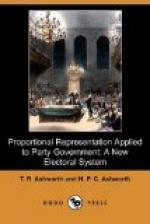Which of these methods is correct? Should we select the surplus from all votes, original and transferred, as Sir John Lubbock proposes; from all transferred votes only, with Mr. Clark; or from the last packet only of transferred votes, with Professor Nanson? Consider a group of electors having somewhat more than a quota of votes at its disposal. If it nominates one candidate only every one of the electors will have a voice in the distribution of the surplus, but if it puts up three candidates, two of whom are excluded and the third elected, Mr. Clark would allow those who supported the two excluded candidates to decide the distribution of the surplus, and Professor Nanson only those who supported the last candidate excluded. Both are clearly wrong, for the only rational view to take is that when a candidate is excluded it is the same as if he had never been nominated and the transferred votes had formed part of the original votes of those to whom they are transferred. Whenever a surplus is created it should therefore be distributed by reference to all votes, original and transferred. As regards these surpluses, Mr. Clark and Professor Nanson have adopted an arbitrary basis, which is no more than Sir John Lubbock has done; and they have therefore eliminated the element of chance only for surpluses on the first count. It may be asked, Why cannot all surpluses be distributed by reference to all the papers, if that is the correct method? The answer is that the complication involved is enormous. Yet this was the plan first advocated by Professor Nanson, who wrote, in reply to a definite inquiry how the Gregory principle was applied:—“I explain by an example. A has 2,000 votes, the quota being 1,000. A then requires only half the value of each vote cast for him. Each paper cast for him is then stamped as having lost one-half of its value, and the whole of A’s papers are then transferred with diminished value to the second name (unelected, of course). The same principle applies all through. Whenever anyone has a surplus all the papers are passed to the next man with diminished value.” Now, the effect of this extraordinary proposal would be that the whole of the papers would have to be kept in circulation till the last candidate was elected, with diminishing compound fractional values. In a ten-seat electorate a large proportion would pass through several transfers, and would towards the end of the count have such a ridiculously small fractional value that it would take several millions of the ballot-papers to make a single vote! It is no wonder that this method was abandoned when the complications to which it would lead were realized.
A simple method of avoiding this complexity would be to treat transferred surplus papers as if the preferences were exhausted. It must be remembered that in all transfers a certain number of papers are lost owing to the preferences being exhausted, and the additional loss would be small. Thus at the first Hobart election 206 votes were wasted, and this number would have been increased by two only. Every surplus would then be transferred by reference to the next choice, wherever expressed, on both original papers and papers transferred from excluded candidates.




